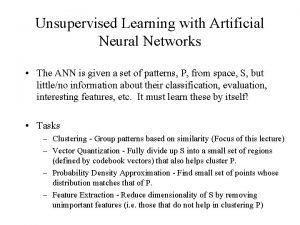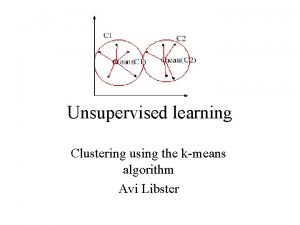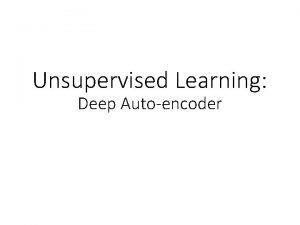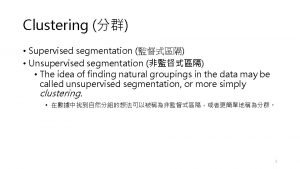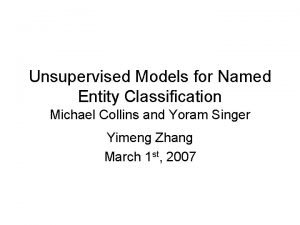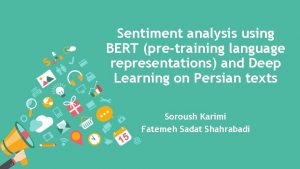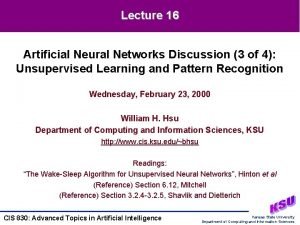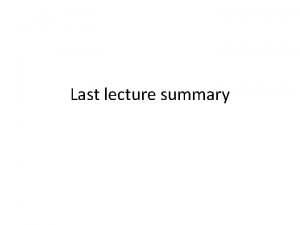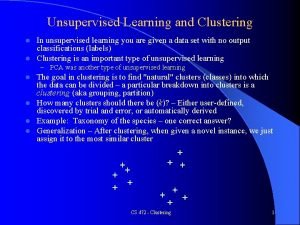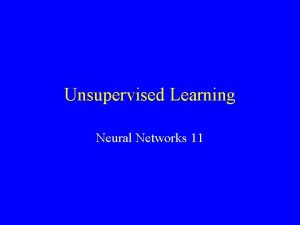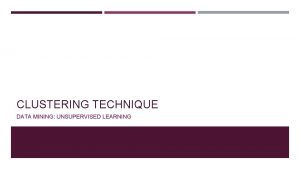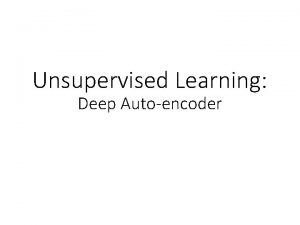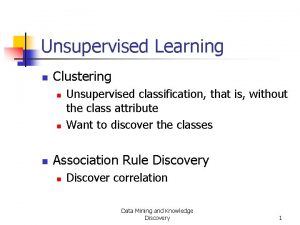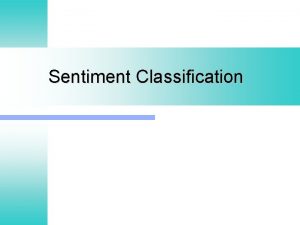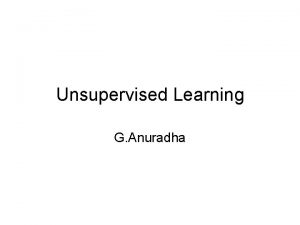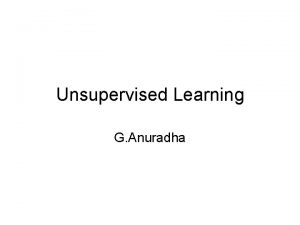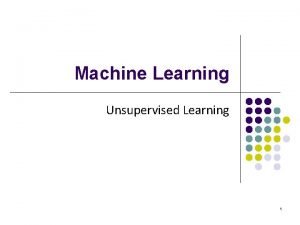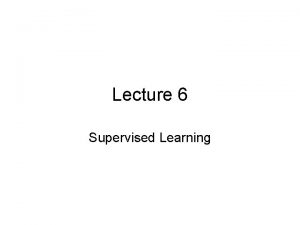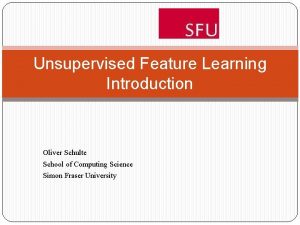Chapter 5 Unsupervised learning Introduction Unsupervised learning Training






















- Slides: 22

Chapter 5 Unsupervised learning

Introduction • Unsupervised learning – Training samples contain only input patterns • No desired output is given (teacher-less) – Learn to form classes/clusters of sample patterns according to similarities among them • Patterns in a cluster would have similar features • No prior knowledge as what features are important for classification, and how many classes are there.

Introduction • NN models to be covered – Competitive networks and competitive learning • Winner-takes-all (WTA) • Maxnet • Hemming net – Counterpropagation nets – Adaptive Resonance Theory – Self-organizing map (SOM) • Applications – Clustering – Vector quantization – Feature extraction – Dimensionality reduction – optimization

NN Based on Competition • Competition is important for NN – Competition between neurons has been observed in biological nerve systems – Competition is important in solving many problems • To classify an input pattern into one of the m classes – idea case: one class node has output 1, all other 0 ; – often more than one class nodes have non-zero output x_1 C_1 x_n C_m INPUT CLASSIFICATION – If these class nodes compete with each other, maybe only one will win eventually and all others lose (winner-takesall). The winner represents the computed classification of the input

• Winner-takes-all (WTA): – Among all competing nodes, only one will win and all others will lose – We mainly deal with single winner WTA, but multiple winners WTA are possible (and useful in some applications) – Easiest way to realize WTA: have an external, central arbitrator (a program) to decide the winner by comparing the current outputs of the competitors (break the tie arbitrarily) – This is biologically unsound (no such external arbitrator exists in biological nerve system).

• Ways to realize competition in NN – Lateral inhibition (Maxnet, Mexican hat) output of each node feeds xi to others through inhibitory connections (with negative weights) xj – Resource competition • output of node k is distributed to node i and j proportional to wik and wjk , as well as xi and xj • self decay • biologically sound xj xi xk

Fixed-weight Competitive Nets • Maxnet – Lateral inhibition between competitors – Notes: • Competition: iterative process until the net stabilizes (at most one node with positive activation) • where m is the # of competitors • too small: takes too long to converge • too big: may suppress the entire network (no winner)

Fixed-weight Competitive Nets • Example θ = 1, ε = 1/5 = 0. 2 x(0) = (0. 5 x(1) = (0 x(2) = (0 x(3) = (0 x(4) = (0 stabilized 0. 9 0. 24 0. 072 0 0 1 0. 36 0. 216 0. 1728 0. 9 0. 24 0. 072 0 0 0. 9 ) initial input 0. 24 ) 0. 072) 0 ) = x(3)

Mexican Hat • Architecture: For a given node, – close neighbors: cooperative (mutually excitatory , w > 0) – farther away neighbors: competitive (mutually inhibitory, w < 0) – too far away neighbors: irrelevant (w = 0) • Need a definition of distance (neighborhood): – one dimensional: ordering by index (1, 2, …n) – two dimensional: lattice


• Equilibrium: – – negative input = positive input for all nodes winner has the highest activation; its cooperative neighbors also have positive activation; its competitive neighbors have negative (or zero) activations.

Hamming Network • Hamming distance of two vectors, dimension n, – Number of bits in disagreement. – In bipolar: of

Hamming Network • Hamming network: net computes – d between an input i and each of the P vectors i 1, …, i. P of dimension n – n input nodes, P output nodes, one for each of P stored vector ip whose output = – d(i, ip) – Weights and bias: – Output of the net:

• Example: – Three stored vectors: – Input vector: – Distance: (4, 3, 2) – Output vector – If we what the vector with smallest distance to I to win, put a Maxnet on top of the Hamming net (for WTA) • We have a associate memory: input pattern recalls the stored vector that is closest to it (more on AM later)

Simple Competitive Learning • Unsupervised learning • Goal: – Learn to form classes/clusters of examplers/sample patterns according to similarities of these exampers. – Patterns in a cluster would have similar features – No prior knowledge as what features are important for classification, and how many classes are there. • Architecture: – Output nodes: Y_1, ……. Y_m, representing the m classes – They are competitors (WTA realized either by an external procedure or by lateral inhibition as in Maxnet)

• Training: – Train the network such that the weight vector wj associated with jth output node becomes the representative vector of a class of input patterns. – Initially all weights are randomly assigned – Two phase unsupervised learning • competing phase: – apply an input vector randomly chosen from sample set. – compute output for all output nodes: – determine the winner among all output nodes (winner is not given in training samples so this is unsupervised) • rewarding phase: – the winner is reworded by updating its weights to be closer to (weights associated with all other output nodes are not updated: kind of WTA) • repeat the two phases many times (and gradually reduce the learning rate) until all weights are stabilized.

• Weight update: – Method 1: Method 2 il – wj il + wj η (il - wj) il il wj wj + η(il - wj) In each method, ηil wj wj + ηil is moved closer to il – Normalize the weight vector to unit length after it is updated – Sample input vectors are also normalized – Distance

• is moving to the center of a cluster of sample vectors after repeated weight updates wj(0) – Node j wins for three training wj(3) samples: i 1 , i 2 and i 3 – Initial weight vector wj(0) wj(1) i 3 – After successively trained by i 1 , i 2 and i 3 , i 1 the weight vector wj(2) changes to wj(1), i 2 wj(2), and wj(3),

Examples • A simple example of competitive learning (pp. 168 -170) – 6 vectors of dimension 3 in 3 classes (6 input nodes, 3 output nodes) – Weight matrices: Node A: for class {i 2, i 4, i 5} Node B: for class {i 3} Node C: for class {i 1, i 6}

Comments 1. Ideally, when learning stops, each is close to the centroid of a group/cluster of sample input vectors. 2. To stabilize , the learning rate may be reduced slowly toward zero during learning, e. g. , 3. # of output nodes: – too few: several clusters may be combined into one class – too many: over classification – ART model (later) allows dynamic add/remove output nodes 4. Initial : – learning results depend on initial weights (node positions) – training samples known to be in distinct classes, provided such info is available – random (bad choices may cause anomaly) 5. Results also depend on sequence of sample presentation

Example w 2 w 1 will always win no matter the sample is from which class is stuck and will not participate in learning unstuck: let output nodes have some conscience temporarily shot off nodes which have had very high winning rate (hard to determine what rate should be considered as “very high”)

Example w 2 Results depend on the sequence of sample presentation w 1 w 2 w 1 Solution: Initialize wj to randomly selected input vector il that are far away from each other
 Supervised learning dan unsupervised learning
Supervised learning dan unsupervised learning Perbedaan supervised dan unsupervised
Perbedaan supervised dan unsupervised Unsupervised learning in data mining
Unsupervised learning in data mining Transductive learning for unsupervised text style transfer
Transductive learning for unsupervised text style transfer Autoencoders, unsupervised learning, and deep architectures
Autoencoders, unsupervised learning, and deep architectures Maxnet neural network
Maxnet neural network Is pca unsupervised learning
Is pca unsupervised learning Unsupervised learning
Unsupervised learning Machine learning andrew ng
Machine learning andrew ng Youtube.com
Youtube.com Contractive autoencoder
Contractive autoencoder Supervised and unsupervised learning
Supervised and unsupervised learning Cuadro comparativo e-learning b-learning m-learning
Cuadro comparativo e-learning b-learning m-learning Unsupervised domain adaptation by backpropagation
Unsupervised domain adaptation by backpropagation Unsupervised segmentation
Unsupervised segmentation Iso cluster unsupervised classification
Iso cluster unsupervised classification Supervised data mining
Supervised data mining Unsupervised models for named entity classification
Unsupervised models for named entity classification Unsupervised sentiment analysis using bert
Unsupervised sentiment analysis using bert Unsupervised pos tagging
Unsupervised pos tagging The wake-sleep algorithm for unsupervised neural networks
The wake-sleep algorithm for unsupervised neural networks Unsupervised hierarchical clustering
Unsupervised hierarchical clustering Generative adversarial networks
Generative adversarial networks





